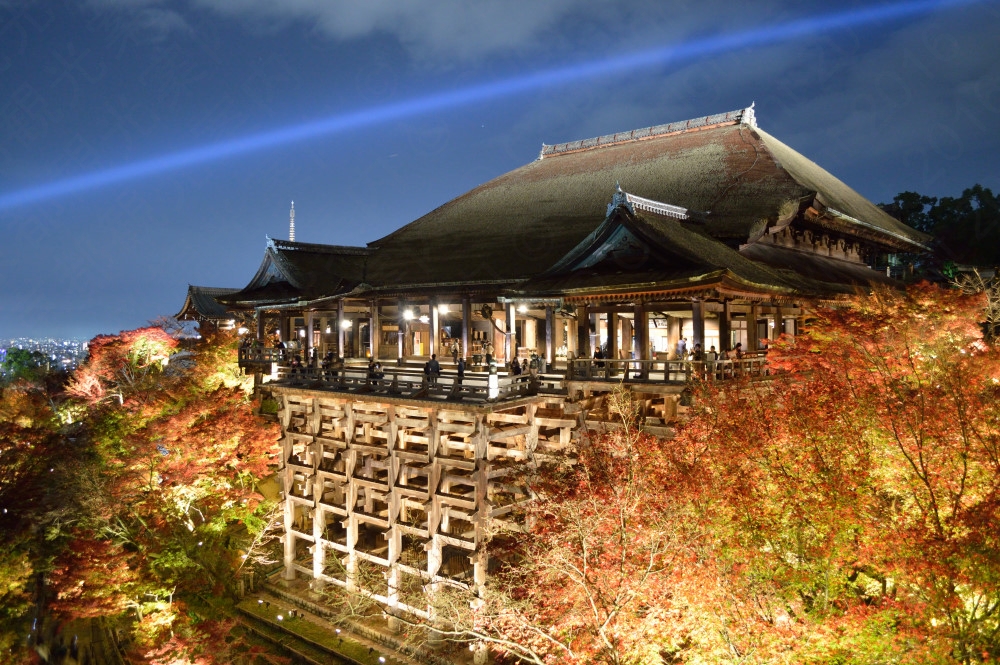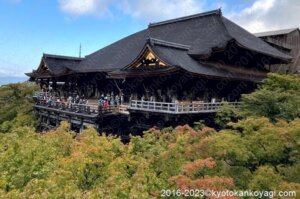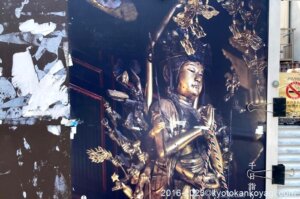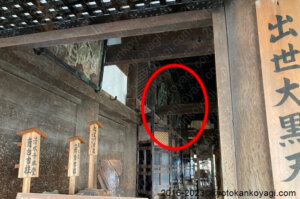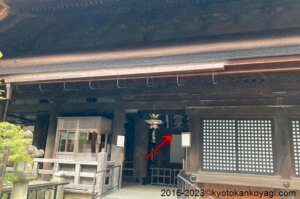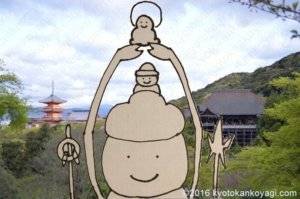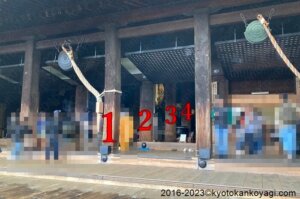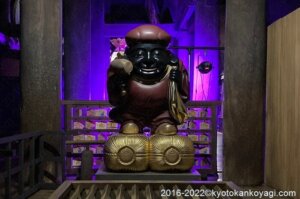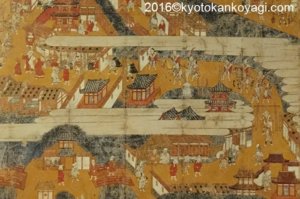THE GIST OF THIS ARTICLE
- Page 1 Introduction, History, Renovation, Deities
- Page 2 Main hall, Stage
- Page 3 Umatodome, Komainus, Niomon Gate, Saimon Gate
- Page 4 Tiger in lantern, Sho Roh and bell, Zuigu Doh temple, Kagekiyo Tsumegata Kannon
- Page 5 Pagoda, Kyo Doh, Tamra Doh, Todoroki Mon gate
- Page 6 Asakura Doh, Bussoku Seki, Iron canes and sandals, Scars of Benkei
- Page 7 Jishu shrine, Shaka Doh, Amida Doh, Oku no In, Koyasu pagoda
- Page 8 Access to Kiyomizudera
The following is the contents of this article.
Introduction 概説
In this post, I’ll show you the history, the stage, seven wonders, and other must-sees. First, the history, the main hall, Goriyaku. Next, other must-sees on the way we take when we visit Kiyomizudera temple. I hope you enjoy Kiyojmizu-derra temple with this post. 合掌
Short history of Kiyomizudera temple 清水寺の歴史
Foundation 創建
Kiyomizudera was founded in 8th century. In 778, Kannon gave an oracle to a monk called Enchin (延鎮) in his dream. She ( Kannnon is a male deity but many people think she is a female deity) said to him in his dream; She asked him to go to Mt. Otowa (音羽), where Kiyomizu-dera is located today.
When Enchin reached Mt. Otowa, he found a Gyoei at a small fall of a golden stream. Gyoei was Kannon. She said to him, “I’ll leave it to you. She left him with a holy wood and Enchin engraved a small Kannon statue with it to enshrine in a hut. This is the begging of Kiyomizudera temple.
After a while, Sakanoue no Tamuramaro, the Shogun of the Imperial court, visited Mt. Otowa to find embryos of Shika deer. At that time, people believed that they were good help for safe delivery.
Enchin said to the Shogun, “You don’t have a right to kill animals for your wife and child’s sake.”
Tamuramaro regretted his intention and donated a part of his edifice as the main hall of Kiyomizudera temple to enshrine the statue of Kannon.
Heian period (8~12th century) 平安時代
In this period, the Imperial Court was developed as a centralized government. People believed in Kannon with no consideration of classes and they visited Kiyomizudera often. Kiyomizudera is described in The tale of Genji, Makurano Soshi (The pillow book) and other famous classic Japanese literature.The stage was build in this period (11~12th century).

Kiyomizudera belonged to Kofukuji temple in Nara. Kofukuji was adversary of Enryakuji. Gion sha, the temple known as Yasaka shrine today, belonged to Enryakuji. Kiyomizudera and Gion sha were in a proxy war and sometimes Kiyomizudera became a battle field.

Meigetsuki (『明月記』), a diary of Fujiwara no Teika, says, ” Kiyomizudera looked like a citadel.”
Kamakura~ Muromach period (12~16th century) 鎌倉~室町時代
In 1188, Amidado of Kiyomizudera was re-established as a place for Nenbutsu, the practice reading out Sutras.
In 1214, some monks betrayed their colleagues and donated Kiyomizudera to Enryakuji. Kiyomizudera belonged to Enryauji and this incident gave a birth to a huge conflict. One month later, the emperor gave Senji (宣旨), the order of His Imperial Majesty, to calm down it.
In 1467, Ohnin no Ran, the largest civil war in Japanese history, broke out. It lasted for a decade and Kyoto was devastated completely. The complex of Kiyomizudera was burned out in 1469. The monks of Kiyomizudera escaped with statues to a safe place.
In 1477, the war ended. Two years later, a brand-new bell was made thanks to many donations.
After that, many monks traveled through the archipelago to ask for donations to reconstruct the complex. Monks used Kiomizudera Sankei Mandala to tell what Kiyomizudera is. (Sorry, so far, only Japanese edition is available)

The bell had been in use nearly 530 years. In 2008, a new one was donated because the old one was damaged seriously.
Edi period (17~19th century) 江戸時代

In this period, Japan enjoyed peace and large conflict did’t occur but Kiyomizudera was caught by fire in 1629. The fire burned all the complex except Nioh Mon gate, Shoro (the housing for the bell) , Kasugasha, and Koyasu no Toh pagoda.
Thanks to the donation of Tokugawa Iemitsu, a grand son of Tokugawa Ieyasu and the 3rd Shogun of the Tokugawa Shogunate, the complex we know today was constructed.

The main hall we see today was constructed in 1633.


In this period, Sennichi Mairi and Tobiochi Gankake became popular among commoners.
Meiji~Reiwa period 19~21st century(明治時代~令和)

As a part of the Meiji restoration, Shibutsu Shugo was abolished. This lead to Haibutsu Kishaku movement and Kiyojmizudera lost its properties.
Kiyomizudera lived through this tough situation with the donations by many believers.


Jishu shrine was separated from Kiyomizudera.
Kiyomizudera has been a temple of Hossoshu school. In 1965, it established North-Hossoshu and became independent.
In 1995, it has registered as a world heritage site.
The renovation of Heisei

In 2008, the renovation of Heisei (and Reiwa) started and ended in 2020. During 12 years, the complex of Kiyomizudera is renovated for the first time in about 50 years. The renonation of the roof of the main hall started in 2017. The roof was covered with many layers of tree bark and they were replaced with new ones. The floor of the iconic stage was also replaced. On 12/3/2020, the stage was open to us and the renovation was completed.

The renovation was finished the day before.
Gohonzon and Goriyaku 御本尊とご利益
Gohonzon: Kannnon with 11 faces and 1000 hands 十一面千手千眼観世音菩薩
The Gohonzon of Kiyomizu-dera temple is “Juichimen Senju Kannon,” the Kannon with 11 faces and 1,000 hands. The authenthentic one is enshrined in Zushi at the main hall. Usaually we can admire a replica called Omaedachi. The door of the Zushi opens every 33 years or other special occasions.

There is a disk called Mishotai. It plays the same role as Omaedachi.
It is believed that she appears in 33 forms to save anyone in suffer. This is the reason the Zushi opens in every 33 years.
Senju Kannon exactly means “Kannon with 1,000 eyes and hands.” Senju Kannon has 1,000 arms and each palms has 1,000 eyes. She saves people in suffer with them.

In a nutshell, she saves people in suffer with every possible way.

At the exit of the main hall, we can find a huge plate says “慈眼視衆生 福聚海無量,” the last sentence in the Kannon’s Sutra. The sentence means what シカさん said just a moment ago.
The statue of Kiyomizudera is in Seisuiji Shiki style. Seisuiji Shiki Kannnon statue has extra 2 hands to hold a satue of Siddhartha Gautama over her head.
Goriyaku ご利益
She has many Goriyaku good fortune: She saves us every bad luck. In addition to it, she gives us victory. This is based on the story of Sakanoue Tamuramaro. Kannon saves him and his collogues when he was in a battlefield,

I’ll tell you the story later.
The most famous one was safe delivery. For over 1,000 years, Kiyomizudera was famous for the Goriyaku many people don’t know today. It is based on a story of Tamuramaro’s embryo searching. Even today, we can find a Hara Obi at Jimusyo (the place amulets are sold).

Hra Obi (腹帯) is a wide towel for pregnant a pregnant woman. She wears around abdomen to warm her coming baby.

Wakiji/ Kyoji 脇侍
Wakiji/ Kyoji is a deity who helps the main one. Kannon has 2 Wakijis: Basu Sennnin (婆藪仙人) and Daiben Kudoku Ten (大弁功徳天) but Kannon of Kiyomizudra has Syogun Jizo Bosatsu(勝軍地蔵菩薩立像) and Shoteki Bishamon Ten (勝敵毘沙門天立像) instead. There is a story about them.
One day, Sakanoue no Tamuramaro and his army headed to Ezochi in western Japan (the region known as Tohoku today) to fight Emishi, the tribe that was not under the control of the Imperial Court and inhabited there.

He was a Seii Taisyogun (征夷大将軍), the Shogun fight against the western barbarians. His duty was to conquer the western region of Japan.
When he left Kyoto, Enchin gave the statues of Jizo Bosatsu and Bisyamon Ten. When he was in the inferior position to the enemy. He asked help for Kannon in his heart. Then, Jizo Bosatsu and Bisyamon came out of nowhere to save him and his army.

They also are the guardians of Heiankyo (ancient name of Kyoto) . Jizo Bosatsu is in Mt. Atago and Bisyamon Ten is in Mt. Kurama.

When you’re in the main hall, stand between 2 and 3 pillars. Then turn left and look up to the ceiling. You’ll find a huge plate hanging on the wall . The picture on the plate shows you the story. But I guess it’s too dark to see it.
The statues of these deities are enshrined in Zushi as the satue of Kannon. These deities don’t have Omaedachi. They only have Mishotai.
The gardians 二十八部衆・風神雷神
Inside of the main hall, there are three Zushis for three deities previously told. Between these Zushis, there many statues of deities. They are Niju Hchibu Shu, Husjin, and Raijin. They are the guadians of Buddhism and Kannon.
Shusse Daikokuten 出世大黒天
After the Todoroki Mon gate (I’ll show you later), we’ll find a statue standing on golden rice containers. He is Shusse Daikokuten, the deity of prosperity. He welcomes visitors over 500 years. He used to be in an island in the Kamo river but is in the main hall now.


He is illuminated with purple light only 1 day a year. The pink ribbon illumination on 10/1.

